Measurement of Synergy Degree between Environmental Protection and Industrial Development in the Yellow River Basin and Analysis of Its Temporal and Spatial Characteristics
Abstract
1. Introduction
2. Synergistic Mechanism between Environment and Industry in the Yellow River Basin
2.1. Structural Analysis of Environmental and Industrial Compound System in Yellow River Basin
2.2. Analysis on the Synergistic Conditions of Environmental and Industrial Compound System in the Yellow River Basin
2.3. Self-Organizing Evolution of Environmental and Industrial Compound System in the Yellow River Basin
3. Materials and Methods
3.1. Research Methodology
3.1.1. Synergy Model of Compound Systems
3.1.2. Global Spatial Autocorrelation
3.2. Indicator System and Data Sources
4. Results and Discussion
4.1. Time Evolution Analysis
4.2. Spatial Evolutionary Analysis
4.2.1. Spatial Divergence Analysis
4.2.2. Spatial Correlation Analysis
5. Conclusions
Author Contributions
Funding
Institutional Review Board Statement
Informed Consent Statement
Data Availability Statement
Conflicts of Interest
References
- Wang, J.N. A primary framework on protection of ecological environment and realization of high-quality development for the Yellow River Basin. Environ. Prot. 2020, 48, 18–21. [Google Scholar]
- Weng, G.M.; Tang, Y.B.; Pan, Y.; Mao, Y.Q. Spatiotemporal evolution and spatial difference of tourism-ecology-urbanization coupling coordination in Beijing-Tianjin-Hebei urban agglomeration. Econ. Geogr. 2021, 41, 196–204. [Google Scholar]
- Jiang, Y.H.; Guo, X.M.; Ni, H.L. Research on the ecological environment synergy of cross-border e-commerce logistics industry based on the compound synergy model. Fresenius Environ. Bull. 2021, 30, 13118–13125. [Google Scholar]
- Cao, H.H.; Li, Y.; Yan, X.Y. Dynamic coupling in an eco-agricultural system in a highland lake basin: A case study of Erhai Lake. J. Hydroecol. 2018, 39, 18–26. [Google Scholar]
- Xiang, L. A study on the spatial and temporal differentiation of tourism industry-urbanization-ecological environment coordination in Yangtze River Economic Zone. Ecol. Econ. 2017, 33, 115–120. [Google Scholar]
- Gelso, B.R.; Peterson, J.M. The influence of ethical attitudes on the demand for environmental recreation: Incorporating lexicographic preferences. Ecol. Econ. 2005, 53, 35–45. [Google Scholar] [CrossRef]
- Zheng, S.W.; Bian, X.H. Research on mechanism for coordinated development of tourism and environment pollution control: An empirical study of Haken Model. Ecol. Econ. 2016, 32, 122–125. [Google Scholar]
- Liu, Z.H.; Li, T.Z.; Xiao, R.Q. Empirical analysis of coordination degree of urbanization development in Beijing-Tianjin-Hebei region. Stat. Decis. 2019, 35, 112–116. [Google Scholar]
- Guo, Z.A.; Shen, X.F. Synergetics; Shanxi Economic Publishing House: Taiyuan, China, 1991; p. 2. [Google Scholar]
- Haken, H. Synergetics. In Instruction and Advanced Topics, 3rd ed.; Springer: Berlin/Heidelberg, Germany, 2004; pp. 24–45. [Google Scholar]
- Hu, X.M.; Wang, Z.Y. Introduction to the Environment; Northeastern University Press: Shenyang, China, 2000. [Google Scholar]
- Wu, P.; Sui, B.Z.; Chen, X. Situation analysis of basic endowment insurance for the urban working group system from the perspective of dissipative structure theory. China Soft Sci. 2015, 293, 173–183. [Google Scholar]
- Su, Y. Large and medium sized enterprises’ technology innovation based on the theory of dissipative structures. J. Ind. Eng. Eng. Manag. 2013, 27, 107–114. [Google Scholar]
- Yang, G.P. Economics of Industry; Fudan University Press: Shanghai, China, 2005; pp. 7–8. [Google Scholar]
- Ren, B.P.; Du, Y.X. Coupling coordination of economic growth, industrial development and ecology in the Yellow River Basin. China Popul. Resour. Environ. 2021, 31, 119–129. [Google Scholar]
- Meng, Q.S.; Han, W.X. Study of the coordinating measurement model with respect to composite system. Trans. Tianjin Univ. 2000, 33, 444–446. [Google Scholar]
- Wu, C.X. Research on the synergistic effect of low-carbon economy in China. J. Manag. World 2021, 37, 105–117. [Google Scholar]
- Sang, R.C.; Wang, H.L. Home market, industrial agglomeration and regional wage disparity. Ind. Econ. Res. 2011, 55, 28–36+62. [Google Scholar]
- Zhang, Y.; Wang, F.Y. Research on competitiveness and developing path in Anhui service outsourcing industry—Based on the comparative analysis of service outsourcing industry’s competitiveness of 10 cities in Yangtze Delta. East China Econ. Manag. 2013, 27, 32–38. [Google Scholar]
- Guan, H. Capital allocation on science and technology of enterprises and competitiveness of China’s high-tech industry. Sci. Manag. Res. 2018, 36, 62–65. [Google Scholar]
- Ye, C.; Pi, J.W.; Chen, H.Q. Coupling Coordination Development of the Logistics Industry, New Urbanization and the Ecological Environment in the Yangtze River Economic Belt. Sustainability 2022, 14, 5298. [Google Scholar]
- Ning, C.S.; Li, S.D. Dynamic evaluation of synergy between ecological protection and economic development in the Yellow River Basin. Yellow River 2020, 42, 1–6. [Google Scholar]
- Yellow River Conservancy Commission Huang Hezhi General Editing Office. Annals of the Yellow River Volume 2 Overview of the Yellow River Basin; Henan People’s Publishing House: Zhengzhou, China, 2017; pp. 50–60. [Google Scholar]
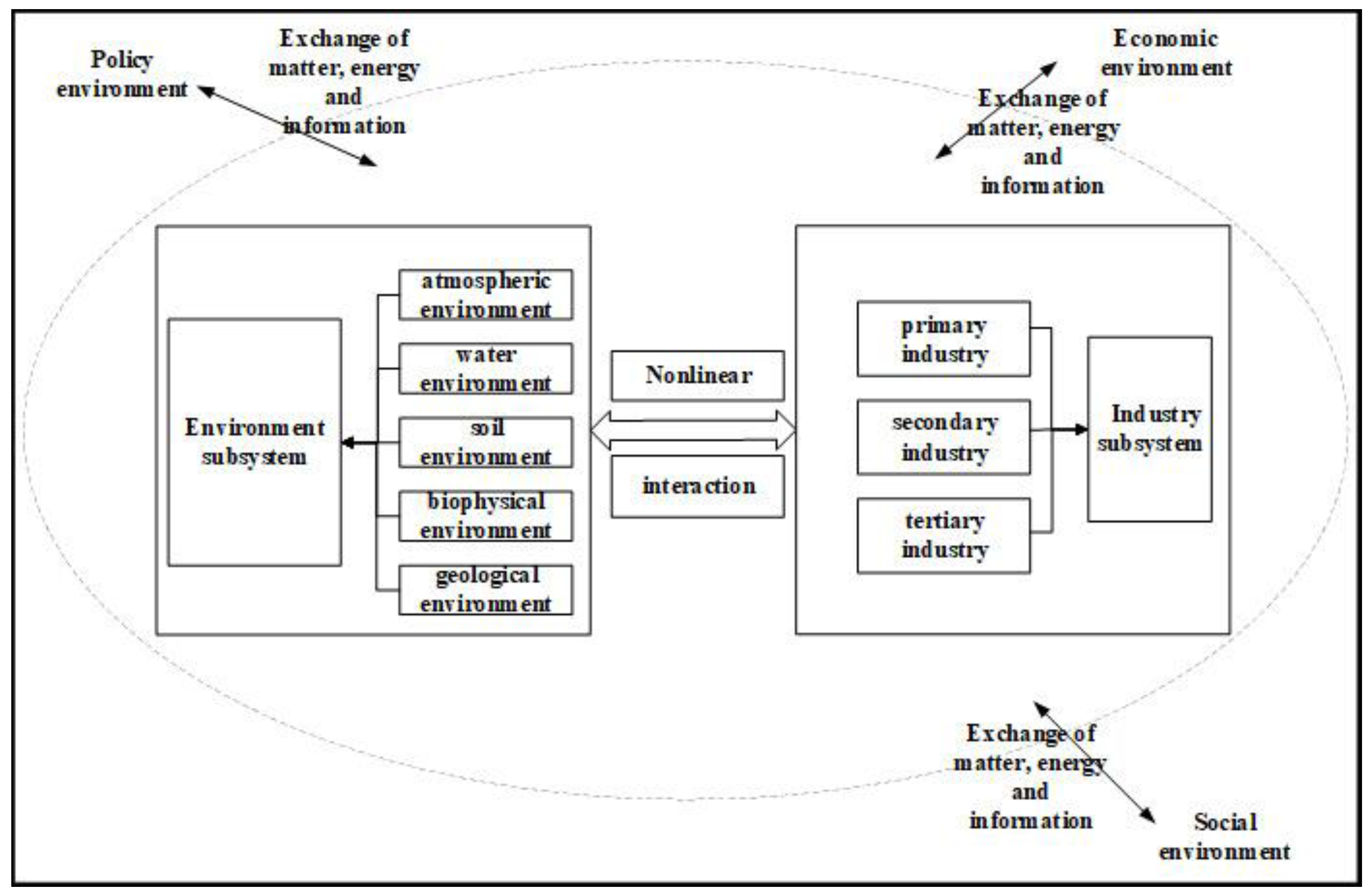
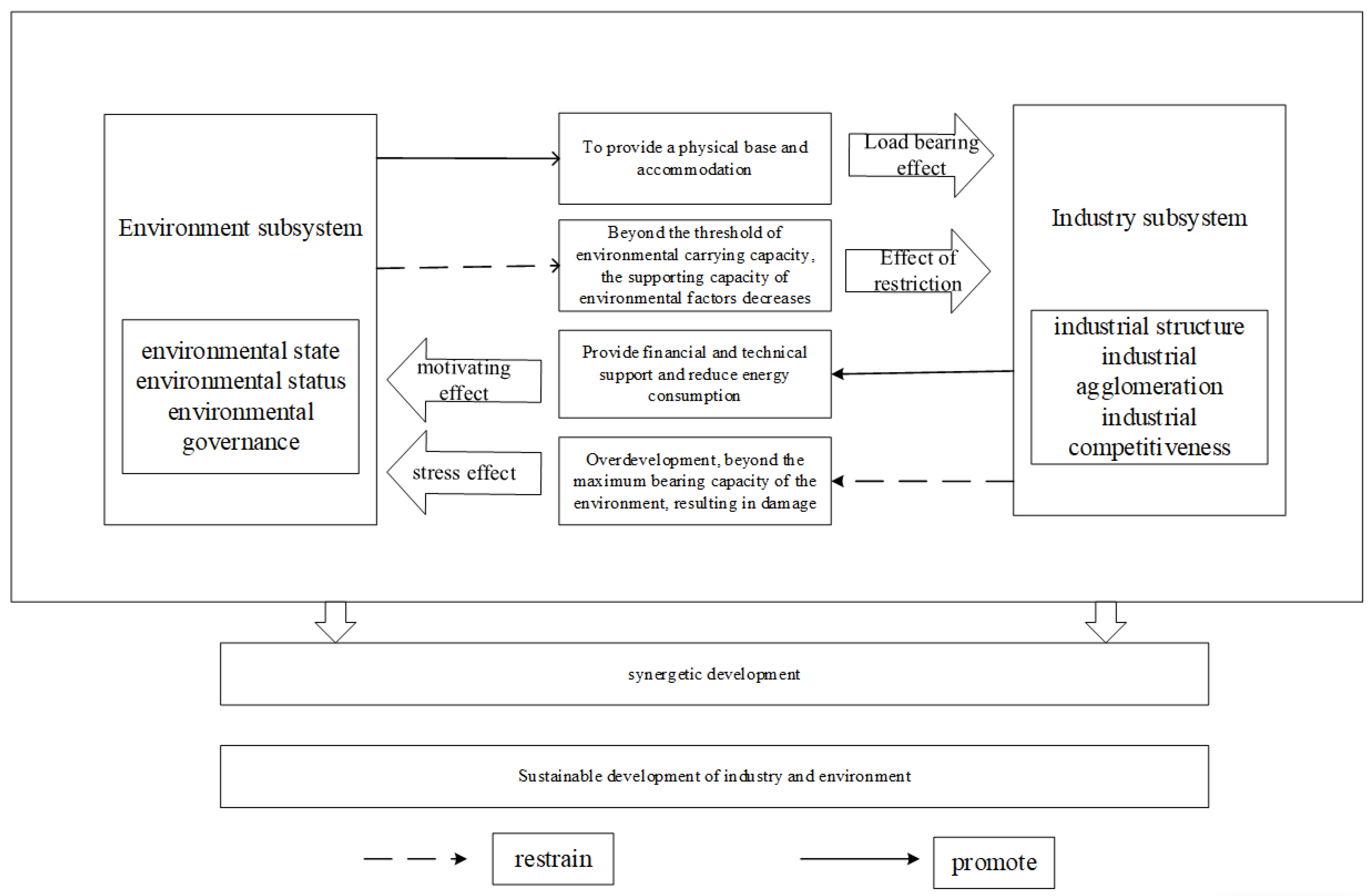
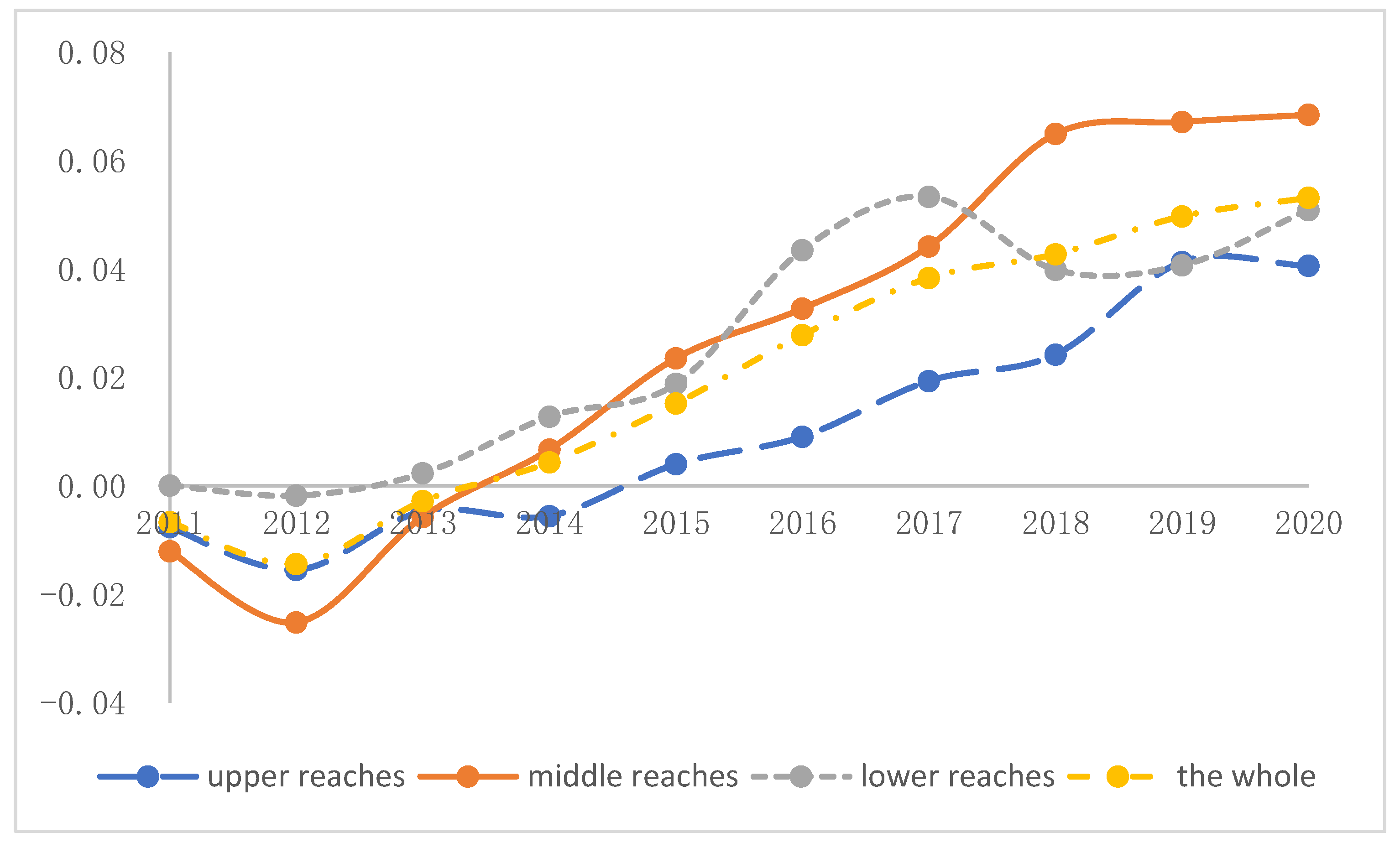
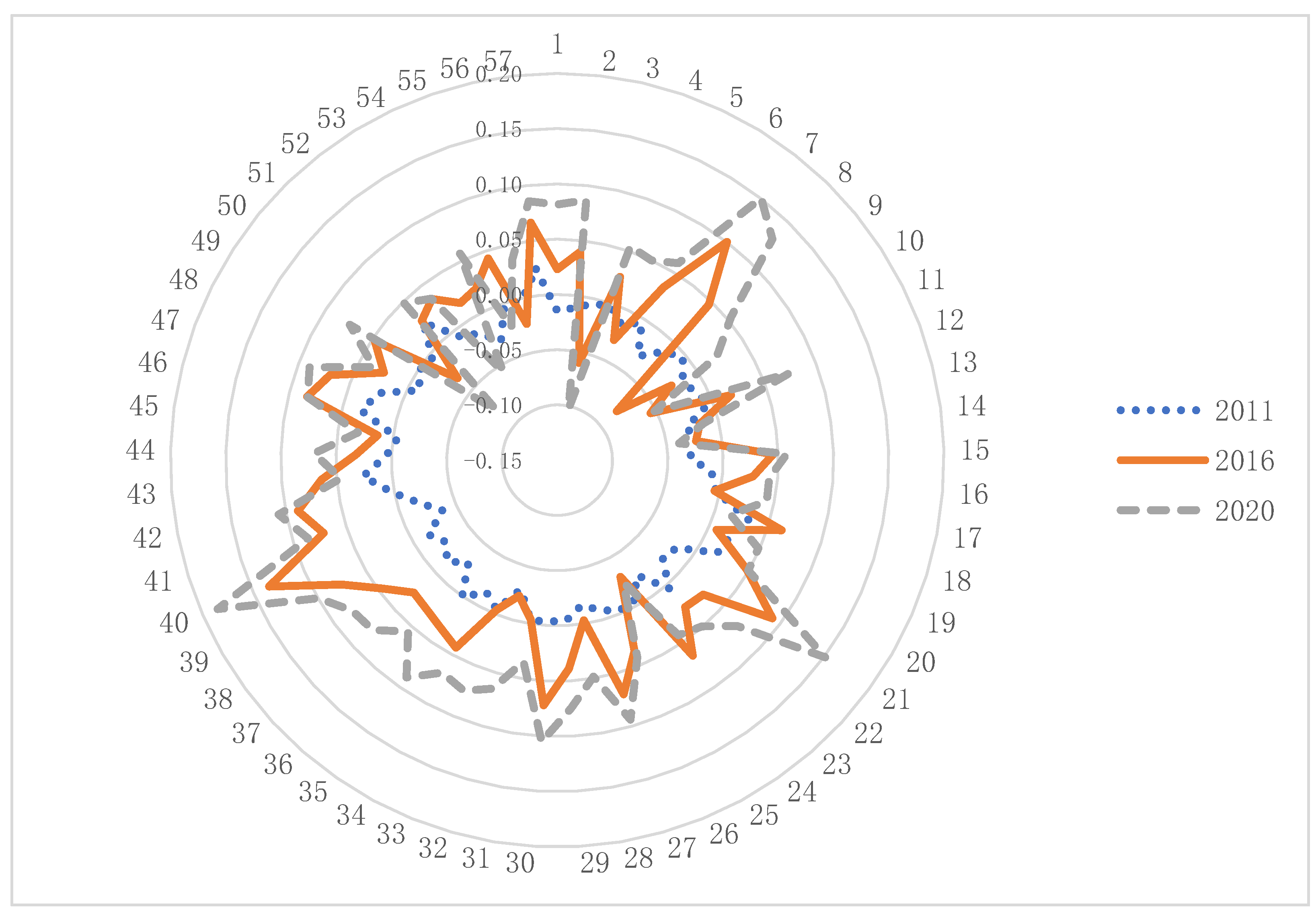
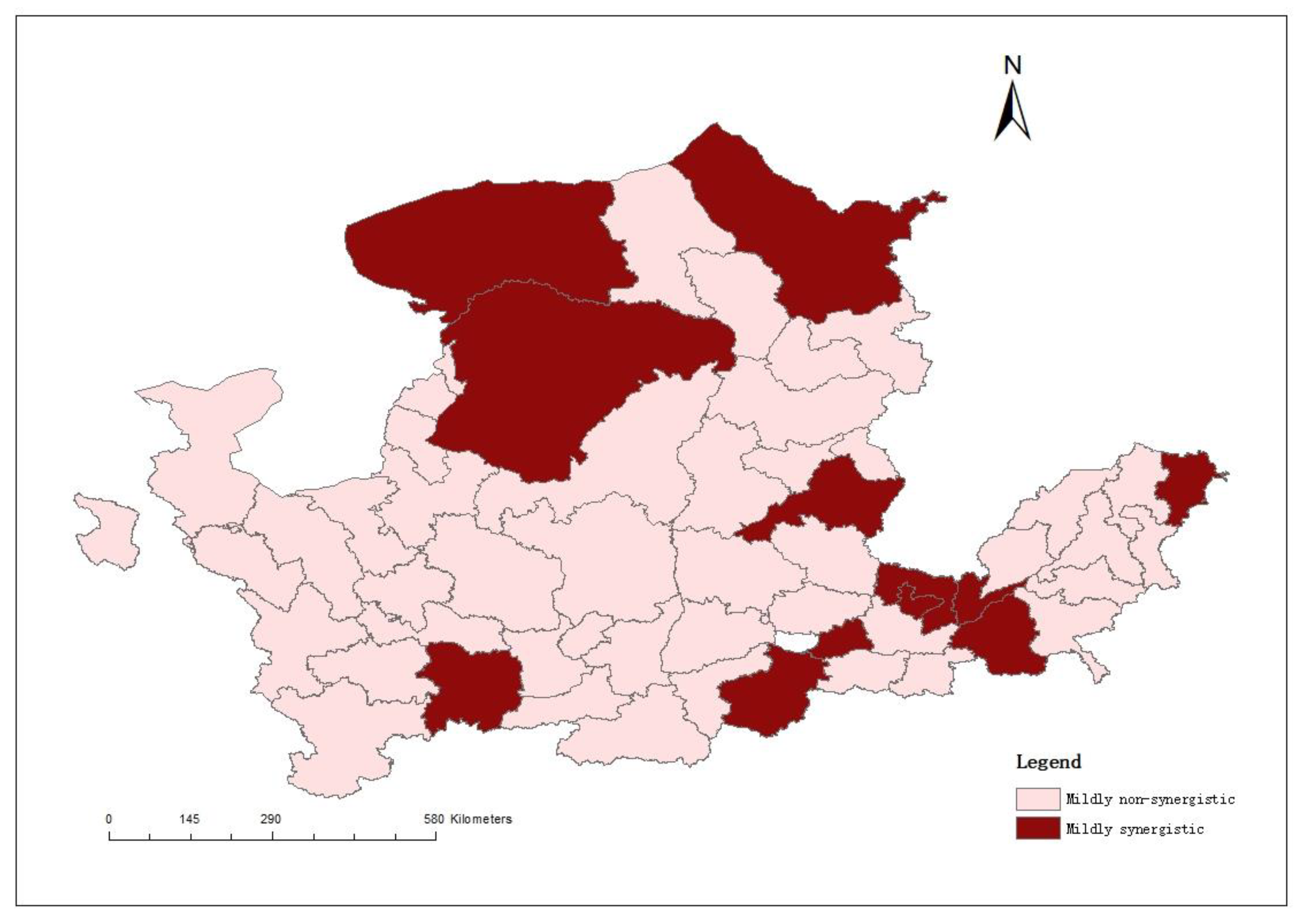
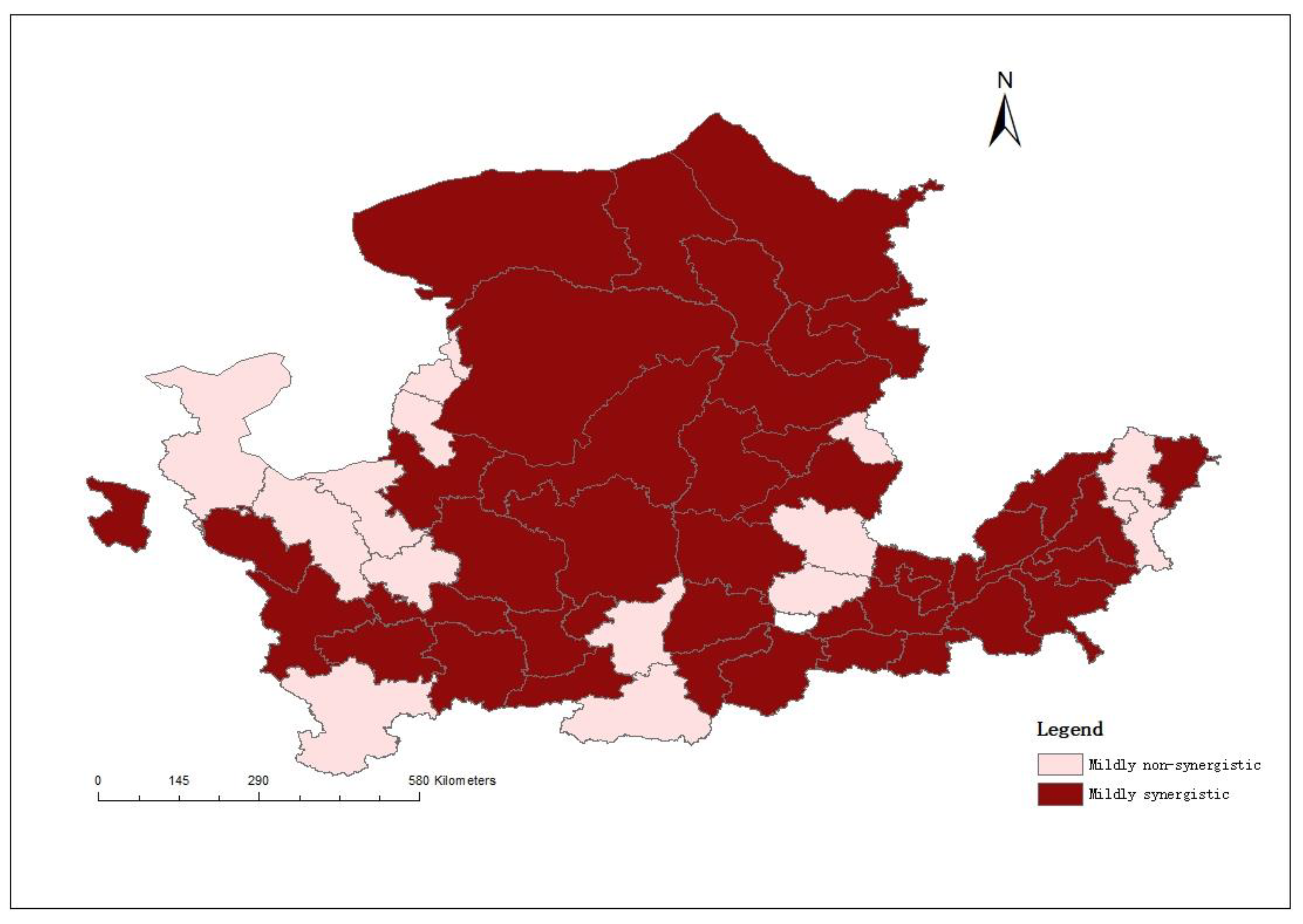
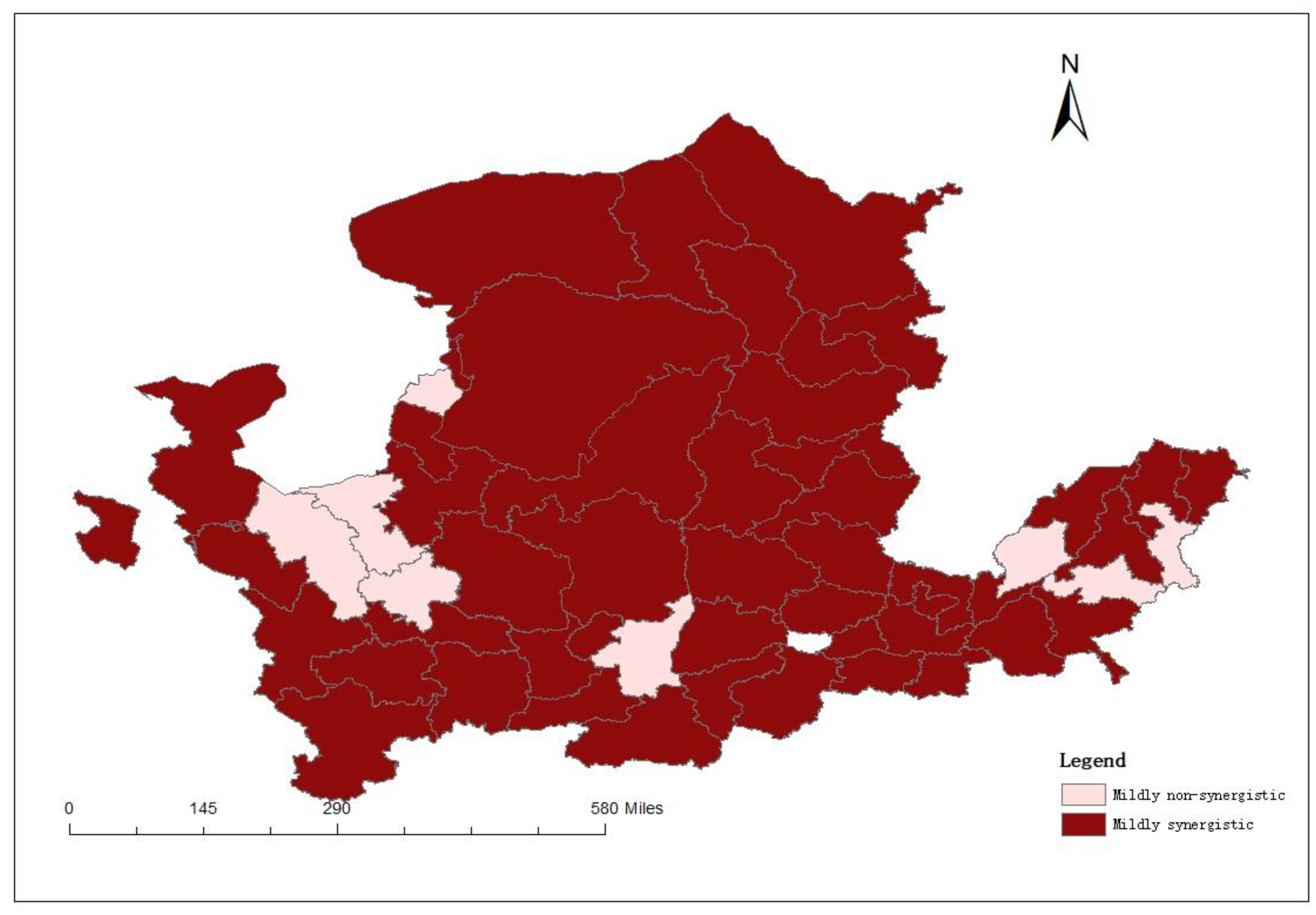
| Synergy Degree | Synergy Level |
|---|---|
| cor ∈ [−1, −0.666] | Highly non-synergistic |
| cor ∈ [−0.666, −0.333] | Moderately non-synergistic |
| cor ∈ [−0.333, 0] | Mildly non-synergistic |
| cor ∈ [0, 0.333] | Mildly synergistic |
| cor ∈ [0.333, 0.666] | Moderately synergistic |
| cor ∈ [0.666, 1] | Highly synergistic |
| Subsystems | Order Parameter | Order Parameter Component (Indicators) | Indicator Units and Properties |
|---|---|---|---|
| Environment Subsystem (E) | Environmental State (E1) | Green space per capita (E11) | m2 (+) |
| Greening coverage of built-up areas (E12) | % (+) | ||
| Total water supply (E13) | 10,000 m³ (+) | ||
| Environmental Status (E2) | Industrial wastewater discharge (E21) | 10,000 tons (−) | |
| Industrial SO2 emissions (E22) | ton (−) | ||
| Industrial smoke (dust) emissions (E23) | ton (−) | ||
| Environmental Governance (E3) | Centralized treatment rate of sewage treatment plants (E31) | % (+) | |
| Harmless disposal rate of domestic waste (E32) | % (+) | ||
| Industry Subsystem (S) | Industry Structure (S1) | Industrial structure advanced index (S11) | (+) |
| Industrial structure rationalization index (S12) | (−) | ||
| Industry Agglomeration (S2) | Zone entropy (S21) | (+) | |
| Industry Competitiveness (S3) | Number of students enrolled in higher education (S31) | the (+) | |
| Total profit of industrial enterprises above the scale (S32) | 10,000 yuan (+) | ||
| Total import and export (S33) | 10,000 dollars (+) |
| Subsystems | Order Parameter Components | Weighting Factor (w) |
|---|---|---|
| Environmental Subsystem | E11 | 0.122 |
| E12 | 0.112 | |
| E13 | 0.126 | |
| E21 | 0.117 | |
| E22 | 0.132 | |
| E23 | 0.139 | |
| E31 | 0.126 | |
| E32 | 0.126 | |
| Industry Subsystem | S11 | 0.176 |
| S12 | 0.204 | |
| S21 | 0.193 | |
| S31 | 0.139 | |
| S32 | 0.155 | |
| S33 | 0.133 |
| Time | Moran’s I | p-Value | Z Test Value | Standard Deviation |
|---|---|---|---|---|
| 2011 | 0.0528 | 0.208 | 0.7842 | 0.0866 |
| 2012 | 0.1041 | 0.094 | 1.3745 | 0.0908 |
| 2013 | 0.1191 | 0.068 | 1.5764 | 0.0871 |
| 2014 | 0.0778 | 0.146 | 1.0575 | 0.0892 |
| 2015 | 0.0224 | 0.314 | 0.4228 | 0.0896 |
| 2016 | 0.1957 | 0.012 | 2.3985 | 0.0884 |
| 2017 | 0.1402 | 0.053 | 1.6600 | 0.0928 |
| 2018 | 0.0871 | 0.141 | 1.0906 | 0.0925 |
| 2019 | 0.1504 | 0.037 | 1.8840 | 0.0882 |
| 2020 | 0.1335 | 0.065 | 1.6374 | 0.0898 |
Disclaimer/Publisher’s Note: The statements, opinions and data contained in all publications are solely those of the individual author(s) and contributor(s) and not of MDPI and/or the editor(s). MDPI and/or the editor(s) disclaim responsibility for any injury to people or property resulting from any ideas, methods, instructions or products referred to in the content. |
© 2023 by the authors. Licensee MDPI, Basel, Switzerland. This article is an open access article distributed under the terms and conditions of the Creative Commons Attribution (CC BY) license (https://creativecommons.org/licenses/by/4.0/).
Share and Cite
Xue, W.; Liu, Y. Measurement of Synergy Degree between Environmental Protection and Industrial Development in the Yellow River Basin and Analysis of Its Temporal and Spatial Characteristics. Sustainability 2023, 15, 3386. https://doi.org/10.3390/su15043386
Xue W, Liu Y. Measurement of Synergy Degree between Environmental Protection and Industrial Development in the Yellow River Basin and Analysis of Its Temporal and Spatial Characteristics. Sustainability. 2023; 15(4):3386. https://doi.org/10.3390/su15043386
Chicago/Turabian StyleXue, Weixian, and Yunru Liu. 2023. "Measurement of Synergy Degree between Environmental Protection and Industrial Development in the Yellow River Basin and Analysis of Its Temporal and Spatial Characteristics" Sustainability 15, no. 4: 3386. https://doi.org/10.3390/su15043386
APA StyleXue, W., & Liu, Y. (2023). Measurement of Synergy Degree between Environmental Protection and Industrial Development in the Yellow River Basin and Analysis of Its Temporal and Spatial Characteristics. Sustainability, 15(4), 3386. https://doi.org/10.3390/su15043386




